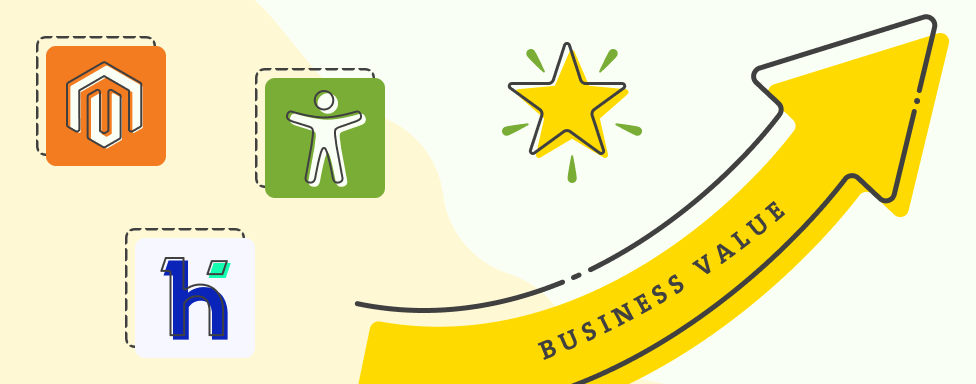Did you know it’s illegal to have an inaccessible site in Norway – that is, a web site that did not invest in accessibility? As technology improves and new legislation that manages accessibility is put into action, accessible design is no longer optional.
With the advent of the European Accessibility Act (EAA) that will come into force in 2025 in the European Union, specific requirements will be set out for products and services to ensure they can be used by people with disabilities. We have already covered these in our two previous blogs dealing with accessibility.
If you missed them, you can find the blogs here:
- Accessibility: What Is It & Why It’s Important
- How to Design in eCommerce with Accessibility in Mind
You can also watch a short summary of the first blog post below!
Accessibility as a Legal Obligation
In the United States, the Americans with Disabilities Act (ADA) defines an eCommerce site as a place of public accommodation. This means that brands and retailers can become the target of lawsuits for failing to provide an accessible shopping experience.
Between 2017 and 2022, over 14,000 digital accessibility lawsuits were filed through U.S. federal courts. With all costs added up, penalties can range up to $150,000 – and more if the lawsuit ends being brought under parallel state human rights laws.
If you are an international business, your legal obligations in regards to accessibility extend beyond your country of origin. With the European Accessibility Act coming very soon into force, companies doing business in the European Union will have to comply with its requirements or face fines and penalties.
Financial Benefits of Investing in Accessibility
Accessibility is not just nice to have – it’s a necessity. The digital marketplace is diverse, with customers of all demographics and abilities. Ensuring that your online store is accessible to everyone isn’t just a matter of social responsibility – it’s also a smart business move.
From a business standpoint, ignoring accessibility features in your product can cut you off from a significant portion of your audience. Accessibility benefits everyone. You may not think about it, but features like dark mode and closed captions are some common accessibility features everyone uses daily – this is the curb cut effect explained in more detail in our previous blog.
When it comes to eCommerce, investing in accessibility can boost revenue. According to LevelAccess’ most recent digital accessibility survey, 85% retail professionals report improvements in custom acquisition and 81% in customer retention. With those numbers it is no surprise 91% consider that digital accessibility gives them a competitive advantage.
A 2019 study by Nucleus Research estimated that companies without accessible sites lose up to $6.9 billion a year. What is important to note here is that the customers that require accessibility when shopping online do not abandon their purchases – they find accessible sites that allow them to complete their purchases. This means the money is lost to competitors whose sites provide accessibility features.
Beyond all that, building an accessible brand boosts customer trust and loyalty as it showcases you value and want to include every customer.
How Hyvä helps achieve accessibility
We’ve already covered some good practices in achieving accessibility in eCommerce in our previous blog. Another factor that can aid you when approaching this topic is utilizing solutions that have already built-in accessibility functionalities, such as the Magento 2 frontend theme Hyvä.
A modern frontend framework for Magento 2, Hyvä gives great weight to accessibility. Among one of the things it seeks to improve is user experience, allowing customers to more easily comply with standards and create inclusive digital experiences.
In order to improve its accessibility features, Hyvä partnered with Snowdog, a Magento agency from Poland. The primary aim of this endeavor was to provide a more inclusive experience for all users, as well as compliance with the Americans with Disabilities Act (ADA) and the European Accessibility Act (EAA).
The team focused on several factors:
- Frontend code accessibility – the team worked to ensure all elements, features, and actions within the theme were accessible and understandable to assistive technologies (AT) and systems.
- Alternative text and descriptions – to enhance perception and comprehension, the team added alternative text for all meaningful interactive elements lacking visual labels. This feature allowed users who depend on assistive technologies to understand and interact with the content effectively.
- Design considerations – elements such as font size, and spacing to ensure legibility and readability across devices were enhanced with the aim of creating a visually inclusive experience for all users.
- Keyboard and assistive technology support – another important aspect of accessibility was ensuring all features and interactions in the Hyvä theme were keyboard-accessible and compatible with assistive technologies.
Additionally, Hyvä achieves the curb cut effect by reducing energy consumption since it makes website pages lighter to load and can reduce merchants servers needs by 25%.
The Value of Accessibility
And that’s it! Through our three blogs, we’ve covered the importance of accessibility in eCommerce, the core resources and practices that can help you in its implementation, as well as the business value of investing in accessibility.
By now, it’s clear there are many upsides to ensuring your online store is accessible. Not only from a legal and financial standpoint, but from an empathetic point of view, letting your customers know your brand values and wants to make its experience available for everyone.
Above all, building a reputation as a company that values accessibility and inclusion is as important as fulfilling all the requirements of implementing it and will foster loyalty among your customers.



